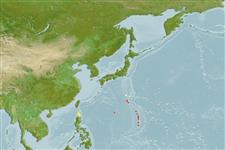Common names from other countries
Environment: milieu / climate zone / depth range / distribution range
Ecología
marino asociado a arrecife; no migratorio; rango de profundidad 1 - 56 m (Ref. 1602). Tropical; 28°N - 15°N
Distribución
Países | Áreas FAO | Ecosistemas | Ocurrencias, apariciones | Point map | Introducciones | Faunafri
Western Pacific: known only from the Mariana and Ogasawara Islands; possibly a population southwest of Palau.
Tamaño / Peso / Age
Maturity: Lm ? range ? - ? cm
Max length : 9.0 cm TL macho / no sexado; (Ref. 9710); common length : 7.0 cm SL macho / no sexado; (Ref. 37816)
Espinas dorsales (total) : 14; Radios blandos dorsales (total) : 16 - 18; Espinas anales: 3; Radios blandos anales: 17 - 18. Its ground color is variable, ranging from almost red to light apricot. The barring can be reduced to a small patch behind the operculum, and in rare cases, be entirely absent. The blue trim on the soft dorsal and anal fins is absent or reduced in females and highly developed in males.
A common species (Ref. 9710) found singly or in small groups in exposed outer reef slopes and occasionally in clear lagoon reefs. Prefers areas of mixed dead and living corals with numerous shelter holes and passages (Ref. 1602). Feeds mainly on benthic algae. Forms harems of 3-7 individuals. Occasionally exported through the aquarium trade (Ref. 48391).
Life cycle and mating behavior
Maturities | Reproducción | Spawnings | Egg(s) | Fecundities | Larva
Allen, G.R., 1985. Butterfly and angelfishes of the world. Vol. 2. 3rd edit. in English. Mergus Publishers, Melle, Germany. (Ref. 4858)
IUCN Red List Status (Ref. 130435)
CITES (Ref. 128078)
Not Evaluated
Threat to humans
Harmless
Human uses
Pesquerías: comercial; Acuario: Comercial
Herramientas
Special reports
Download XML
Fuentes de Internet
Estimates based on models
Phylogenetic diversity index (Ref.
82804): PD
50 = 0.5000 [Uniqueness, from 0.5 = low to 2.0 = high].
Bayesian length-weight: a=0.03090 (0.01359 - 0.07026), b=2.89 (2.70 - 3.08), in cm Total Length, based on LWR estimates for this (Sub)family-body shape (Ref.
93245).
Nivel trófico (Ref.
69278): 2.0 ±0.00 se; based on food items.
Resiliencia (Ref.
120179): Alto, población duplicada en un tiempo mínimo inferior a 15 meses (Preliminary K or Fecundity.).
Fishing Vulnerability (Ref.
59153): Low vulnerability (10 of 100).
